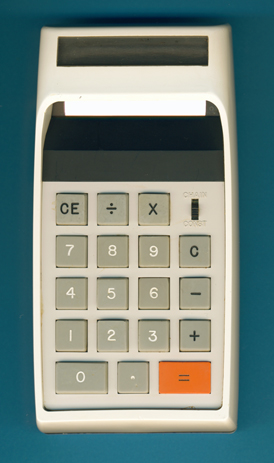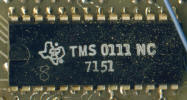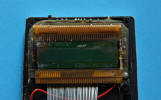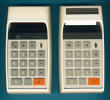
DATAMATH CALCULATOR MUSEUM
 |
DATAMATH CALCULATOR MUSEUM |
Texas Instruments Minimath Version 0 - Early Prototype
| Date of introduction: | Never | Display technology: | LCD transmissive |
| New price: | Display size: | 8 | |
| Size: | 5.5" x 3.0" x 1.7" 139 x 76 x 42 mm3 |
||
| Weight: | 7.0 ounces, 199 grams | Serial No: | 19 |
| Batteries: | 6*AA | Date of manufacture: | wk 52 year 1971 |
| AC-Adapter: | AC9100 | Origin of manufacture: | USA |
| Precision: | Integrated circuits: | TMS0111 | |
| Memories: | |||
| Program steps: | Courtesy of: | Joerg Woerner |

![]()
![]()

 The famous
TI-2500 Datamath calculator was first announced in
April 1972 with a suggested retail price (SRP) of $149.95. Beginning June 1972
first customers got in the Neiman-Marcus and Sanger-Harris department stores in
Dallas, TX their calculators before the formally
introduction on September 21, 1972.
The famous
TI-2500 Datamath calculator was first announced in
April 1972 with a suggested retail price (SRP) of $149.95. Beginning June 1972
first customers got in the Neiman-Marcus and Sanger-Harris department stores in
Dallas, TX their calculators before the formally
introduction on September 21, 1972.
 The Minimath calculator represent Texas Instruments effort in
the LCD (Liquid-Crystal-Display) technology. One limitation of the early
Datamath calculator was the short operation time although it uses 6 of the
expensive NiCd-cells. A short analysis of the overall power consumption
demonstrates easily that the light-emitting-diodes in conjunction with the
necessary display drivers are the power hungry parts in the calculator design.
The Minimath calculator represent Texas Instruments effort in
the LCD (Liquid-Crystal-Display) technology. One limitation of the early
Datamath calculator was the short operation time although it uses 6 of the
expensive NiCd-cells. A short analysis of the overall power consumption
demonstrates easily that the light-emitting-diodes in conjunction with the
necessary display drivers are the power hungry parts in the calculator design.
 The TMS0100 "Calculator-on-a-Chip" itself was designed in a low-power
PMOS-process. Engineers at Texas Instruments started the design of a LCD for the
Datamath and named the calculator "Minimath".
The TMS0100 "Calculator-on-a-Chip" itself was designed in a low-power
PMOS-process. Engineers at Texas Instruments started the design of a LCD for the
Datamath and named the calculator "Minimath".
 The Minimath uses the
TMS0111 variation of the TMS0100 design. Read more about Texas Instruments' "Calculator-on-a-Chip".
The Minimath uses the
TMS0111 variation of the TMS0100 design. Read more about Texas Instruments' "Calculator-on-a-Chip".
 The Minimath uses a
transmissive LCD instead of todays reflective LCD's and added a lightpath to
illuminate the display with the ambient light from the back.
The Minimath uses a
transmissive LCD instead of todays reflective LCD's and added a lightpath to
illuminate the display with the ambient light from the back.
 Because of the
short life expectancy of the LCD's at that time, Minimath was never put into
production but defined already the design of the
Datamath First Series calculators.
Because of the
short life expectancy of the LCD's at that time, Minimath was never put into
production but defined already the design of the
Datamath First Series calculators.
Learn more about the
MINI-MATH from 1986, it is not a calculator, though.
Minimath™ is a trademark of Texas Instruments.
If you have additions to the above article please email: joerg@datamath.org.
© Joerg Woerner, August 4, 2012. No reprints without written permission.